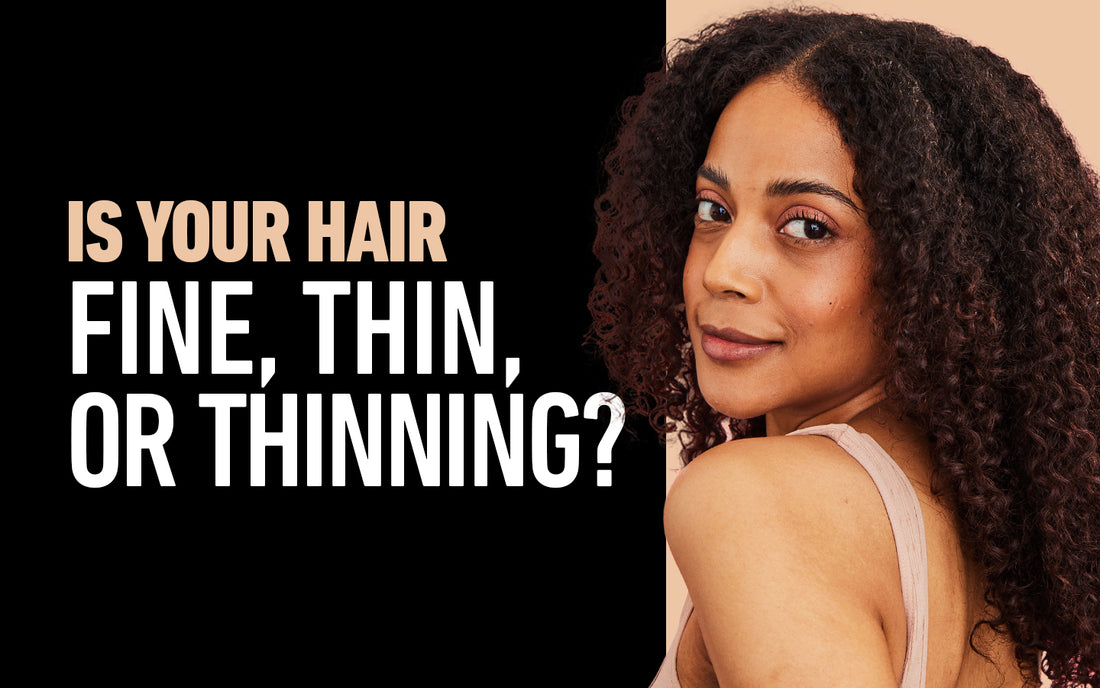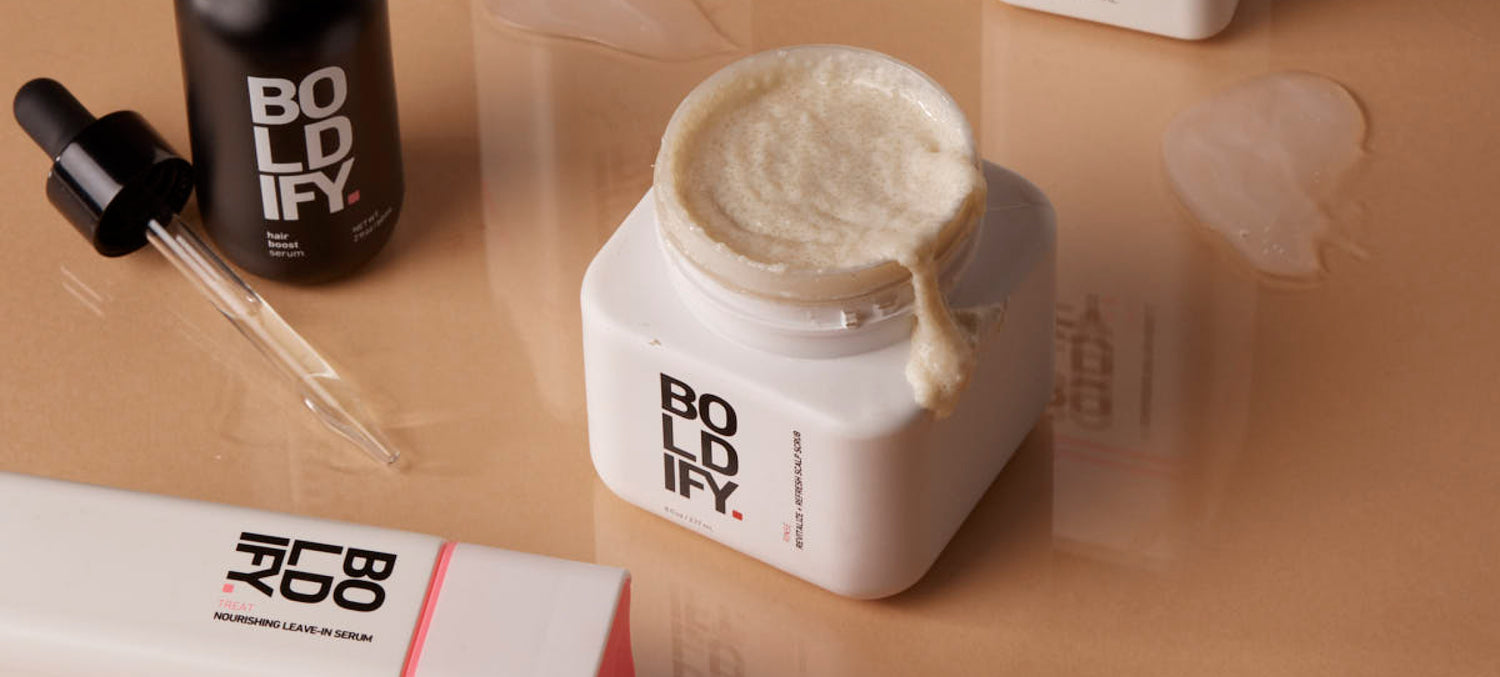Is Your Hair Fine, Thin or Thinning? How to Tell the Difference

Whether you have thin hair or not, we’re all guilty of getting up close and personal with the bathroom mirror, analyzing our strands to see how they’re holding up. Many people use the terms “fine”, “thin”, and “thinning” interchangeably to describe their hair, so it may surprise you that each of these words carries a unique meaning.
If your hair isn’t as thick and full as you would like, it’s important to identify whether your hair is fine, thin, thinning – or a combination of all three. The first step to better, healthier hair is diagnosing the root cause! (No pun intended.)
Understanding the science of your hair will empower you to create the best care and styling routines for your unique hair type. Here’s our guide to differentiating between hair types, and how to make the call:
What is Fine Hair?
First things first, let’s get clear on how fine and thin hair are defined. Fine hair actually refers to the width, diameter, or circumference of the individual hairs on your head. If you have fine hair, the individual strands of hairs on your head are smaller – roughly 50 microns (that’s the term for measuring human hair strands) in diameter. It’s important to note that just because the individual hairs might have a small diameter, it doesn’t affect how many hairs you have on your head. You can have fine hair and still have a lot of it! Coarse hair, on the other hand, is typically about 120 microns in diameter.
Some other characteristics common to fine hair include silky softness, lack of volume, sometimes fragile and prone to breakage, and easily greasy. Here’s the crazy thing about fine hair, because it has nothing to do with the amount of hair on your head and everything to do with the kind of strands on your head, you can still have fine hair made up of course strands and it doesn’t mean the overall density of your hair is thick. Still with us?
Here are two ways to figure out if you have fine hair:
1. Take one individual hair and roll it between your fingers. If you do not feel the h1. Take one individual hair and roll it between your fingers. If you do not feel the hair, your hairis fine. If you feel it, your hair is medium. If you feel a strong, thick strand, your hair is coarse.
2. Take one individual hair and lay it next to a piece of sewing thread in a contrasting color. If your hair is the same width as the thread, it has a medium texture. If your hair is thinner than the thread, you have fine hair. If your hair is thicker than the thread, you have coarse hair.
What Is Thin Hair?
A person with thin hair has fewer hairs on their head. As discussed above, the hair’s texture (the diameter of each individual strand) has nothing to do with the density (the number of hairs you actually have on your head).
The total number of follicles and individual hairs determines if you have thin, medium, or thick hair. The average person has about 100,000 hairs – which would be considered medium or an average density. People with thin hair have 80,000 or fewer hairs; folks with a thick hair density have 150,000 or more hairs.
It is important to understand that a person could have coarse (wide diameter) and thin (low density) hair at the same time. Someone else could have fine (small diameter) and thick (high density) hair at the same time. A smart hair-care plan needs to take into account BOTH texture and density for best results.

What Is Thinning Hair?
Thinning hair has nothing to do with your original hair type, strand thickness or density. Any person with any hair type and amount can experience thinning and hair loss. “Thinning hair” simply means that the density is actively decreasing – in other words, your hair is falling out faster than it can grow back.It’s important to note that some hair shedding is totally normal and expected. Most people lose between 50 and 100 strands every day. Keep in mind that if you do not wash and/or brush your hair every day, you will get a build-up of loose hairs. This build-up will continue to accumulate until your hair is shampooed and brushed. Also, different hair types shed at different rates; thick hair sheds more than thin hair, and long hair sheds more than short hair.
All that to say – finding a few strands of hair on your brush isn’t a reason to panic! If your hair looks and feels healthy and does not appear thinner than usual, there’s nothing to worry about.
But if you find yourself losing clumps of hair on a regular basis, you’re developing bald spots or widening parts, or you notice other sudden changes in your hair thickness or density, it may be time to do a little detective work to figure out what’s going on. There are many possible causes for thinning hair, including some that are out of your control (hi, genetics). But knowing the facts and science of your hair is an essential tool.
Once you pinpoint the potential cause(s) of the thinning, you can begin to better understand your hair from the inside out and respond with a care routine that is informed and intentional. This empowers not only your own understanding, but also that of any professional you may consult with regarding the diagnosis and treatment of your hair.
Important note: Sudden or severe hair loss can be a symptom of possible medical or nutritional problems. In this case, it is recommended to see a doctor before trying to remedy the hair loss on your own.
Signs Your Hair is Thinning
If you’re up close to the mirror analyzing (and possibly obsessing? We won’t judge) your hair follicles and you’re convinced your hair is indeed thinning, here are some signs to help confirm it:
Bald Patches - Probably the most significant and noticeable of the signs, if you’re seeing faint bald patches in your hair, this could be an indicator that your hair is starting to thin out.
Exposed Scalp - Like bald patches, exposed scalps are easy to notice if you know how to check for it. If you can see your scalp through your hair (especially when you run your hands through it), this could be a sign your hair is thinning.
Lightweight-feeling Hair - Like we mentioned before, thinning hair can happen gradually and you might not notice that it’s happening at first. Start regularly feeling the weight of your hair when you comb it or run your fingers through it. If it feels like there’s less there and it’s lighter all around, this could be a first sign that you’re losing hair.
Your Ponytail Got Smaller - If you’ve always been able to pop your hair in a pony with only one or two wraps of a hairband but you’ve noticed you need to wrap it multiple times and the ponytail itself feels thinner than it used to, this also might be a sign your hair is starting to thin.
While we understand it might be a bummer to discover that your hair might not just be thin and is actually thinning, the good news is there are changes you can make and products you can use to achieve the looks you want.
Rather than quickly reaching for a possibly harsh hair growth product, using products that seamlessly cover up thinning patches, or even finding new ways to style your hair can dramatically alter the way thinning hair looks.
While growing your hair back is certainly an option, you might find that easing into it by way of fun new styles or temporary cover-ups are just as effective!
Got questions about how to manage your mane in the midst of changes? Thin or thinning, we’ve got you covered. Sign up for our email list below and get access to all of our styling tips and tricks - as well as inside info on Boldify products!


